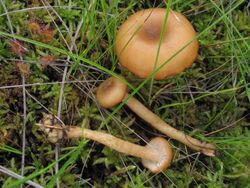Biology:Armillaria ectypa
This article is missing information about Desarmillaria reassignment. (March 2017) |
| Armillaria ectypa | |
|---|---|

| |
| Scientific classification | |
| Domain: | Eukaryota |
| Kingdom: | Fungi |
| Division: | Basidiomycota |
| Class: | Agaricomycetes |
| Order: | Agaricales |
| Family: | Physalacriaceae |
| Genus: | Armillaria |
| Species: | A. ectypa
|
| Binomial name | |
| Armillaria ectypa (Fr.) Lamoure (1965)
| |
| Synonyms[2] | |
| |
Armillaria ectypa is a species of mushroom in the family Physalacriaceae. Commonly known as the marsh honey fungus, it prefers growing in sphagnum bogs with mosses. It is classified as endangered in Great Britain, and is protected under the Wildlife and Countryside Act 1981; it is also on the provisional European red data list.[3] A. ectypa has been observed to have both bioluminescent mycelium and fruitbodies (mainly the gills).[4]
Description
The cap can grow to 10 cm (4 in) in diameter, and is convex at first becoming flattened with age, sometimes developing a depressed centre. The cap has a slightly curved margin and is often striate with the gills visible through its thin structure. The centre is dark brown and scaly. The rest of the cap is yellowish-brown to brown, paler when it is dry and darker when it is moist. The gills are rather narrow and decurrent, whitish at first, becoming cream, buff or pinkish. The stem is up to 10 cm (4 in) tall, cylindrical and slightly swollen at the base. It is the same colour as the cap. There are no mycelial cords at the base of the stem. The spore print is white.[5][6]
Distribution and habitat
The marsh honey fungus has a boreal and montane Eurasian distribution. In Europe, it has been recorded in Austria, Switzerland, the Czech Republic, Denmark, Sweden, Finland, France, Germany, Poland, the British Isles, the Netherlands, Russia and Slovakia. In Asia, it has been recorded in China, Japan and Turkey. Its typical habitat is in waterlogged habitats, in raised bogs, peat mires and alkaline fens, among Sphagnum mosses, sedges, cottongrass and reeds.[6] It is uncommon or rare across the whole of its range. It grows on the Garron Plateau in County Antrim in Northern Ireland, this being one of the only four known sites in the British Isles.[5]
See also
References
- ↑ Svetasheva T. (2015). "Armillaria ectypa". The IUCN Red List of Threatened Species (2015). doi:10.2305/IUCN.UK.2015-4.RLTS.T75097245A75098379.en.
- ↑ "GSD Species Synonymy: Armillaria ectypa (Fr.) Lamoure". CAB International. Species Fungorum. http://www.speciesfungorum.org/GSD/GSDspecies.asp?RecordID=326450. Retrieved 2015-12-14.
- ↑ "Action plan for Armillaria ectypa". UK Biodiversity Plan. 1999. http://www.ukbap.org.uk/UKPlans.aspx?ID=111. Retrieved 2009-04-17.
- ↑ Ainsworth, Martyn (October 2004). "Searching for luminous mushrooms of the Marsh Fungus Armillaria ectypa" (in en). Field Mycology 5 (4): 142–144. doi:10.1016/S1468-1641(10)60279-4.
- ↑ 5.0 5.1 Allen & Mellon Environmental Ltd.. "Armillaria ectypa – marsh honey fungus". Northern Ireland Priority Species. http://www.habitas.org.uk/priority/species.asp?item=665. Retrieved 2020-03-07.
- ↑ 6.0 6.1 Stasinska, Malgorzata (2015). "Armillaria ectypa, a rare fungus of mire in Poland". Acta Mycologica 50. doi:10.5586/am.1064.
Wikidata ☰ Q4793461 entry
 |


